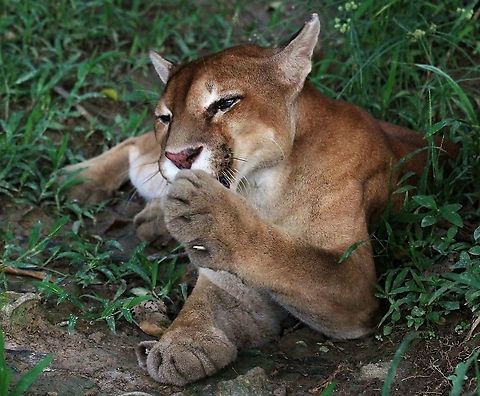
Appearance
Cougars are slender and agile members of the cat family. They are the fourth-largest cat; adults stand about 60 to 90 cm tall at the shoulders. Adult males are around 2.4 m long nose-to-tail and females average 2.05 m , with overall ranges between 1.5 to 2.75 m nose to tail suggested for the species in general. Of this length, 63 to 95 cm is comprised by the tail. Males typically weigh 53 to 100 kg , averaging 62 kg . Females typically weigh between 29 and 64 kg , averaging 42 kg . Cougar size is smallest close to the equator, and larger towards the poles. The largest recorded cougar, shot in 1901, weighed 105.2 kg ; claims of 125.2 kg and 118 kg have been reported, though they were most likely exaggerated. On average, adult male cougars in British Columbia weigh 56.7 kg and adult females 45.4 kg , though several male cougars in British Columbia weighed between 86.4 and 95.5 kg .The head of the cat is round and the ears are erect. Its powerful forequarters, neck, and jaw serve to grasp and hold large prey. It has five retractable claws on its forepaws and four on its hind paws. The larger front feet and claws are adaptations to clutching prey.
Cougars can be almost as large as jaguars, but are less muscular and not as powerfully built; where their ranges overlap, the cougar tends to be smaller on average. Besides the jaguar, the cougar is on average larger than all felids apart from lions and tigers. Despite its size, it is not typically classified among the "big cats", as it cannot roar, lacking the specialized larynx and hyoid apparatus of ''Panthera''. Compared to "big cats", cougars are often silent with minimal communication through vocalizations outside of the mother-offspring relationship. Cougars sometimes voice low-pitched hisses, growls, and purrs, as well as chirps and whistles, many of which are comparable to those of domestic cats. They are well known for their screams, as referenced in some of their common names, although these screams are often misinterpreted to be the calls of other animals.
Cougar coloring is plain but can vary greatly between individuals and even between siblings. The coat is typically tawny, but ranges to silvery-grey or reddish, with lighter patches on the underbody, including the jaws, chin, and throat. Infants are spotted and born with blue eyes and rings on their tails; juveniles are pale, and dark spots remain on their flanks. Despite anecdotes to the contrary, all-black coloring has never been documented in cougars. The term "black panther" is used colloquially to refer to melanistic individuals of other species, particularly jaguars and leopards.
Cougars have large paws and proportionally the largest hind legs in the cat family. This physique allows it great leaping and short-sprint ability. The cougar's top running speed ranges between 64 and 80 km/h , but is best adapted for short, powerful sprints rather than long chases. It is adept at climbing, which allows it to evade canine competitors. Although it is not strongly associated with water, it can swim.
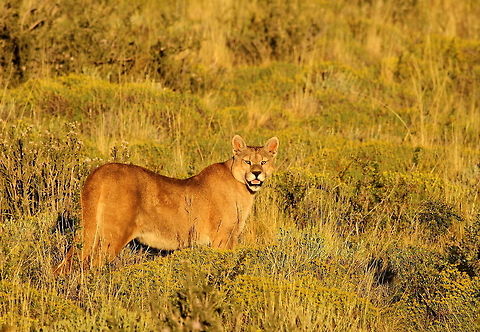
Naming
With its vast range across the length of the Americas, ''P. concolor'' has dozens of names and various references in the mythology of the indigenous Americans and in contemporary culture. Currently, it is referred to as "puma" by most scientists and by the populations in 21 of the 23 countries in the Americas where "puma" is the common name in Spanish or Portuguese. The cat has many local or regional names in the United States and Canada, of which cougar, puma, mountain lion, and panther are popular. "Mountain lion" was a term first used in writing in 1858 from the diary of George A. Jackson of Colorado. Other names include catamount , mountain screamer, and painter. Lexicographers regard painter as a primarily upper-Southern US regional variant on panther. The word panther is commonly used to specifically designate the black panther, a melanistic jaguar or leopard, and the Florida panther, a subspecies of cougar .''P. concolor'' holds the Guinness record for the animal with the greatest number of names, with over 40 in English alone.
"Cougar" may be borrowed from the archaic Portuguese ''çuçuarana''; the term was originally derived from the Tupi language ''susua'rana'', meaning "similar to deer ". A current form in Brazil is ''suçuarana''. It may also be borrowed from the Guaraní language term ''guaçu ara'' or ''guazu ara''. Less common Portuguese terms are ''onça-parda'' or ''leão-baio'' , or unusually non-native ''puma'' or ''leão-da-montanha'', more common names for the animal when native to a region other than South America . People in rural regions often refer to both the cougar and the jaguar as simply ''gata'' , and outside of the Amazon, both are colloquially referred to as simply ''onça'' by many people .
In the 17th century, German naturalist Georg Marcgrave named the cat the ''cuguacu ara''. Marcgrave's rendering was reproduced by his associate, Dutch naturalist Willem Piso, in 1648. ''Cuguacu ara'' was then adopted by English naturalist John Ray in 1693. The French naturalist Georges-Louis Leclerc, Comte de Buffon in 1774 converted the ''cuguacu ara'' to ''cuguar'', which was later modified to "cougar" in English.
The first English record of "puma" was in 1777, where it had come from the Spanish, who in turn borrowed it from the Peruvian Quechua language in the 16th century, where it means "powerful".Until the late 1980s, as many as 32 subspecies were recorded; genetic study of mitochondrial DNA found many of these are too similar to be recognized as distinct at a molecular level. Following the research, the canonical ''Mammal Species of the World'' recognizes six subspecies, five of which are solely found in Latin America:
⤷ Argentine cougar Pocock, 1940: includes the previous subspecies and synonyms ''hudsonii'' and ''puma''
⤷ Costa Rican cougar Merriam, 1901
⤷ Eastern South American cougar Nelson and Goldman, 1931: includes the previous subspecies and synonyms ''acrocodia'', ''borbensis'', ''capricornensis'', ''concolor'', ''greeni'', and ''nigra''
⤷ North American cougar Kerr, 1792: includes the previous subspecies and synonyms ''arundivaga'', ''aztecus'', ''browni'', ''californica'', ''floridana'', ''hippolestes'', ''improcera'', ''kaibabensis'', ''mayensis'', ''missoulensis'', ''olympus'', ''oregonensis'', ''schorgeri'', ''stanleyana'', ''vancouverensis'', and ''youngi''
⤷ Northern South American cougar Linnaeus, 1771: includes the previous subspecies and synonyms ''bangsi'', ''incarum'', ''osgoodi'', ''soasoaranna, sussuarana'', ''soderstromii'', ''suçuaçuara'', and ''wavula''
⤷ Southern South American cougar Molina, 1782: includes the previous subspecies and synonyms ''araucanus'', ''concolor'', ''patagonica'', ''pearsoni'', and ''puma''
''Incerta sedis''
⤷ Florida panther
The status of the Florida panther remains uncertain. It is still regularly listed as subspecies ''P. c. coryi'' in research works, including those directly concerned with its conservation. Culver et al. noted low microsatellite variation in the Florida panther, possibly due to inbreeding; responding to the research, one conservation team suggests, "the degree to which the scientific community has accepted the use of genetics in puma taxonomy is not resolved at this time."The pertinent North American subspecies is ''P. concolor couguar''.
Due to the expanding human population, cougar ranges increasingly overlap with areas inhabited by humans. Attacks on humans are very rare, as cougar prey recognition is a learned behavior and they do not generally recognize humans as prey. Attacks on people, livestock, and pets may occur when a puma habituates to humans or is in a condition of severe starvation. Attacks are most frequent during late spring and summer, when juvenile cougars leave their mothers and search for new territory.
Between 1890 and 1990, in North America there were 53 reported, confirmed attacks on humans, resulting in 48 nonfatal injuries and 10 deaths of humans . By 2004, the count had climbed to 88 attacks and 20 deaths.
Within North America, the distribution of attacks is not uniform. The heavily populated state of California has seen a dozen attacks since 1986 , including three fatalities. Lightly populated New Mexico reported an attack in 2008, the first there since 1974.
As with many predators, a cougar may attack if cornered, if a fleeing human stimulates their instinct to chase, or if a person "plays dead". Standing still may cause the cougar to consider a person easy prey. Exaggerating the threat to the animal through intense eye contact, loud shouting, and any other action to appear larger and more menacing, may make the animal retreat. Fighting back with sticks and rocks, or even bare hands, is often effective in persuading an attacking cougar to disengage.
When cougars do attack, they usually employ their characteristic neck bite, attempting to position their teeth between the vertebrae and into the spinal cord. Neck, head, and spinal injuries are common and sometimes fatal. Children are at greatest risk of attack, and least likely to survive an encounter. Detailed research into attacks prior to 1991 showed that 64% of all victims – and almost all fatalities – were children. The same study showed the highest proportion of attacks to have occurred in British Columbia, particularly on Vancouver Island where cougar populations are especially dense. Preceding attacks on humans, cougars display aberrant behavior, such as activity during daylight hours, a lack of fear of humans, and stalking humans. There have sometimes been incidents of pet cougars mauling people.
Research on new wildlife collars may be able to reduce human-animal conflicts by predicting when and where predatory animals hunt. This can not only save human lives and the lives of their pets and livestock but also save these large predatory mammals that are important to the balance of ecosystems.The puma of the plains of South America is noted for its extreme unwillingness to attack humans. According to the Anglo-Argentine naturalist William Henry Hudson "It does not attack man, and Azara is perfectly correct when he affirms that it never hurts, or threatens to hurt, man or child, even when it finds them sleeping. This, however, is not a full statement of the facts; the puma will not even defend itself against man". And: "All who have killed or witnessed the killing of the puma—and I have questioned scores of hunters on this point—agree that it resigns itself in this unresisting, pathetic manner to death at the hands of man. Claudio Gay, in his Natural History of Chili, says, "When attacked by man its energy and daring at once forsake it, and it becomes a weak, inoffensive animal, and trembling, and uttering piteous moans, and shedding abundant tears, it seems to implore compassion from a generous enemy". Hudson adds that, except in relation to man, the puma is a ferocious animal, attacking even the much stronger jaguar.
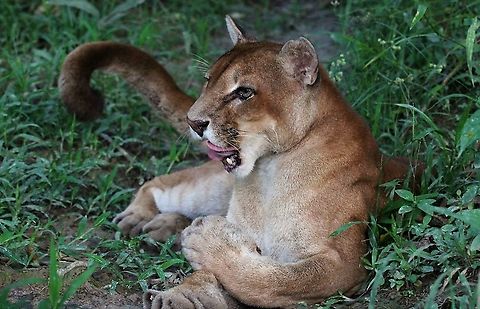
Distribution
The cougar has the largest range of any wild land animal in the Americas. Its range spans 110 degrees of latitude, from northern Yukon in Canada to the southern Andes. Its wide distribution stems from its adaptability to virtually every habitat type: it is found in all forest types, as well as in lowland and mountainous deserts. The cougar prefers regions with dense underbrush, but can live with little vegetation in open areas. Its preferred habitats include precipitous canyons, escarpments, rim rocks, and dense brush.The cougar was extirpated across much of its eastern North American range in the two centuries after European colonization, and faced grave threats in the remainder of its territory. Currently, it ranges across most western American states, the Canadian provinces of Alberta, Saskatchewan and British Columbia, and the Canadian territory of Yukon. There have been widely debated reports of possible recolonization of eastern North America. DNA evidence has suggested its presence in eastern North America, while a consolidated map of cougar sightings shows numerous reports, from the mid-western Great Plains through to eastern Canada. The Quebec wildlife services also considers cougar to be present in the province as a threatened species after multiple DNA tests confirmed cougar hair in lynx mating sites. The only unequivocally known eastern population is the Florida panther, which is critically endangered. There have been unconfirmed sightings in Elliotsville Plantation, Maine ; and in New Hampshire, there have been unconfirmed sightings as early as 1997. In 2009, the Michigan Department of Natural Resources confirmed a cougar sighting in Michigan's Upper Peninsula. Typically, extreme-range sightings of cougars involve young males, which can travel great distances to establish ranges away from established males; all four confirmed cougar kills in Iowa since 2000 involved males.
On April 14, 2008, police shot and killed a cougar on the north side of Chicago, Illinois. DNA tests were consistent with cougars from the Black Hills of South Dakota. Less than a year later, on March 5, 2009, a cougar was photographed and unsuccessfully tranquilized by state wildlife biologists in a tree near Spooner, Wisconsin, in the northwestern part of the state.
Other eastern sightings since 2010 have occurred in locations such as Greene County, Indiana, Greenwich and Milford, Connecticut, Morgan County Pike County, and Whiteside County, Illinois, and Bourbon County, Kentucky....hieroglyph snipped...
South of the Rio Grande, the International Union for the Conservation of Nature and Natural Resources lists the cat in every Central and South American country. While specific state and provincial statistics are often available in North America, much less is known about the cat in its southern range.
The cougar's total breeding population is estimated at less than 50,000 by the IUCN, with a declining trend. US state-level statistics are often more optimistic, suggesting cougar populations have rebounded. In Oregon, a healthy population of 5,000 was reported in 2006, exceeding a target of 3,000. California has actively sought to protect the cat and a similar number of cougars has been suggested, between 4,000 and 6,000.
In 2012 research in Río Los Cipreses National Reserve, Chile, based in 18 motion-sensitive cameras counted a population of two males and two females, one of them with at least two cubs, in an area of 600 km2, that is 0.63 cougars every 100 km2.

Status
The World Conservation Union currently lists the cougar as a "least concern" species. The cougar is regulated under Appendix I of the Convention on International Trade in Endangered Species of Wild Fauna and Flora , rendering illegal international trade in specimens or parts.In the United States east of the Mississippi River, the only unequivocally known cougar population is the Florida panther. Until 2011, the United States Fish and Wildlife Service recognized both an Eastern cougar and the Florida panther, affording protection under the Endangered Species Act. Certain taxonomic authorities have collapsed both designations into the North American cougar, with Eastern or Florida subspecies not recognized, while a subspecies designation remains recognized by some conservation scientists. In 2003 the documented count for the Florida sub-population was 87 individuals. In March 2011, the USFWS declared the Eastern cougar extinct. With the taxonomic uncertainty about its existence as a subspecies as well as the possibility of eastward migration of cougars from the western range, the subject remains open.
This uncertainty has been recognized by Canadian authorities. The Canadian federal agency called Committee on the Status of Endangered Wildlife in Canada rates its current data as "insufficient" to draw conclusions regarding the eastern cougar's survival, and says on its Web site "Despite many sightings in the past two decades from eastern Canada, there are insufficient data to evaluate the taxonomy or assign a status to this cougar." Notwithstanding numerous reported sightings in Ontario, Quebec, New Brunswick and Nova Scotia, it has been said that the evidence is inconclusive: ". . . there may not be a distinct 'eastern' subspecies, and some sightings may be of escaped pets."
The cougar is also protected across much of the rest of its range. As of 1996, cougar hunting was prohibited in Argentina, Brazil, Bolivia, Chile, Colombia, Costa Rica, French Guiana, Guatemala, Honduras, Nicaragua, Panama, Paraguay, Suriname, Venezuela, and Uruguay. The cat had no reported legal protection in Ecuador, El Salvador, and Guyana. Regulated cougar hunting is still common in the United States and Canada, although they are protected from all hunting in the Yukon; it is permitted in every U.S. state from the Rocky Mountains to the Pacific Ocean, with the exception of California. Texas is the only state in the United States with a viable population of cougars that does not protect that population in some way. In Texas, cougars are listed as nuisance wildlife and any person holding a hunting or a trapping permit can kill a cougar regardless of the season, number killed, sex or age of the animal. Killed animals are not required to be reported to Texas Parks and Wildlife Department. Conservation work in Texas is the effort of a non-profit organization, Balanced Ecology Inc , as part of their Texas Mountain Lion Conservation Project. Cougars are generally hunted with packs of dogs, until the animal is 'treed'. When the hunter arrives on the scene, he shoots the cat from the tree at close range. The cougar cannot be legally killed without a permit in California except under very specific circumstances, such as when a cougar is in act of pursuing livestock or domestic animals, or is declared a threat to public safety. Permits are issued when owners can prove property damage on their livestock or pets. For example, multiple dogs have been attacked and killed, sometimes while with the owner. Many attribute this to the protection cougars have from being hunted and are now becoming desensitized to humans; most are removed from the population after the attacks have already occurred. Statistics from the Department of Fish and Game indicate that cougar killings in California have been on the rise since the 1970s with an average of over 112 cats killed per year from 2000 to 2006 compared to six per year in the 1970s. They also state on their website that there is a healthy number of cougars in California. The Bay Area Puma Project aims to obtain information on cougar populations in the San Francisco Bay area and the animals' interactions with habitat, prey, humans, and residential communities.
Conservation threats to the species include persecution as a pest animal, environmental degradation and habitat fragmentation, and depletion of their prey base. Wildlife corridors and sufficient range areas are critical to the sustainability of cougar populations. Research simulations have shown that the animal faces a low extinction risk in areas of 2200 km2 or more. As few as one to four new animals entering a population per decade markedly increases persistence, foregrounding the importance of habitat corridors.
On March 2, 2011, the United States Fish and Wildlife Service declared the Eastern cougar officially extinct.
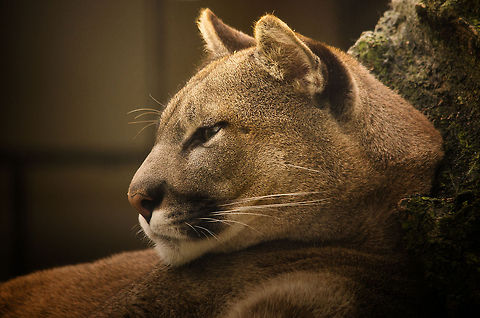
Behavior
Females reach sexual maturity between one-and-a-half to three years of age. They typically average one litter every two to three years throughout their reproductive lives, though the period can be as short as one year. Females are in estrus for about 8 days of a 23-day cycle; the gestation period is approximately 91 days. Females are sometimes reported as monogamous, but this is uncertain and polygyny may be more common. Copulation is brief but frequent. Chronic stress can result in low reproductive rates when in captivity as well as in the field.Only females are involved in parenting. Female cougars are fiercely protective of their cubs, and have been seen to successfully fight off animals as large as Grizzly bears in their defense. Litter size is between one and six cubs; typically two. Caves and other alcoves that offer protection are used as litter dens. Born blind, cubs are completely dependent on their mother at first, and begin to be weaned at around three months of age. As they grow, they begin to go out on forays with their mother, first visiting kill sites, and after six months beginning to hunt small prey on their own. Kitten survival rates are just over one per litter. When cougars are born, they have spots, but they lose them as they grow, and by the age of 2 1/2 years, they will completely be gone
Young adults leave their mother to attempt to establish their own territory at around two years of age and sometimes earlier; males tend to leave sooner. One study has shown high mortality amongst cougars that travel farthest from the maternal range, often due to conflicts with other cougars . Research in New Mexico has shown that "males dispersed significantly farther than females, were more likely to traverse large expanses of non-cougar habitat, and were probably most responsible for nuclear gene flow between habitat patches."
Life expectancy in the wild is reported at eight to 13 years, and probably averages eight to 10; a female of at least 18 years was reported killed by hunters on Vancouver Island. Cougars may live as long as 20 years in captivity. One male North American cougar , named Scratch, was two months short of his 30th birthday when he died in 2007. Causes of death in the wild include disability and disease, competition with other cougars, starvation, accidents, and, where allowed, human hunting. Feline immunodeficiency virus, an endemic HIV-like virus in cats, is well-adapted to the cougar.Like almost all cats, the cougar is a solitary animal. Only mothers and kittens live in groups, with adults meeting only to mate. It is secretive and crepuscular, being most active around dawn and dusk.
Estimates of territory sizes vary greatly. ''Canadian Geographic'' reports large male territories of 150 to 1000 km2 with female ranges half the size. Other research suggests a much smaller lower limit of 25 km2 , but an even greater upper limit of 1300 km2 for males. In the United States, very large ranges have been reported in Texas and the Black Hills of the northern Great Plains, in excess of 775 km2 . Male ranges may include or overlap with those of females but, at least where studied, not with those of other males, which serves to reduce conflict between cougars. Ranges of females may overlap slightly with each other. Scrape marks, urine, and feces are used to mark territory and attract mates. Males may scrape together a small pile of leaves and grasses and then urinate on it as a way of marking territory.
Home range sizes and overall cougar abundance depend on terrain, vegetation, and prey abundance. One female adjacent to the San Andres Mountains, for instance, was found with a large range of 215 km2 , necessitated by poor prey abundance. Research has shown cougar abundances from 0.5 animals to as much as 7 per 100 km2 .
Because males disperse farther than females and compete more directly for mates and territory, they are most likely to be involved in conflict. Where a subadult fails to leave his maternal range, for example, he may be killed by his father. When males encounter each other, they hiss, spit, and may engage in violent conflict if neither backs down. Hunting or relocation of the cougar may increase aggressive encounters by disrupting territories and bringing young, transient animals into conflict with established individuals.
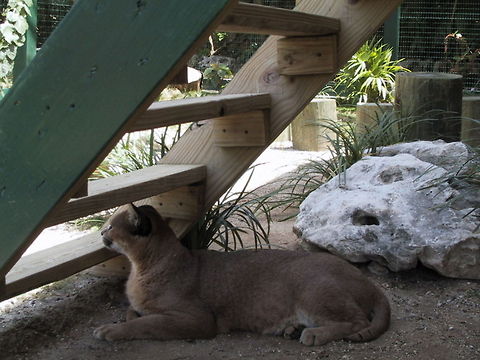
Habitat
The cougar has the largest range of any wild land animal in the Americas. Its range spans 110 degrees of latitude, from northern Yukon in Canada to the southern Andes. Its wide distribution stems from its adaptability to virtually every habitat type: it is found in all forest types, as well as in lowland and mountainous deserts. The cougar prefers regions with dense underbrush, but can live with little vegetation in open areas. Its preferred habitats include precipitous canyons, escarpments, rim rocks, and dense brush.The cougar was extirpated across much of its eastern North American range in the two centuries after European colonization, and faced grave threats in the remainder of its territory. Currently, it ranges across most western American states, the Canadian provinces of Alberta, Saskatchewan and British Columbia, and the Canadian territory of Yukon. There have been widely debated reports of possible recolonization of eastern North America. DNA evidence has suggested its presence in eastern North America, while a consolidated map of cougar sightings shows numerous reports, from the mid-western Great Plains through to eastern Canada. The Quebec wildlife services also considers cougar to be present in the province as a threatened species after multiple DNA tests confirmed cougar hair in lynx mating sites. The only unequivocally known eastern population is the Florida panther, which is critically endangered. There have been unconfirmed sightings in Elliotsville Plantation, Maine ; and in New Hampshire, there have been unconfirmed sightings as early as 1997. In 2009, the Michigan Department of Natural Resources confirmed a cougar sighting in Michigan's Upper Peninsula. Typically, extreme-range sightings of cougars involve young males, which can travel great distances to establish ranges away from established males; all four confirmed cougar kills in Iowa since 2000 involved males.
On April 14, 2008, police shot and killed a cougar on the north side of Chicago, Illinois. DNA tests were consistent with cougars from the Black Hills of South Dakota. Less than a year later, on March 5, 2009, a cougar was photographed and unsuccessfully tranquilized by state wildlife biologists in a tree near Spooner, Wisconsin, in the northwestern part of the state.
Other eastern sightings since 2010 have occurred in locations such as Greene County, Indiana, Greenwich and Milford, Connecticut, Morgan County Pike County, and Whiteside County, Illinois, and Bourbon County, Kentucky....hieroglyph snipped...
South of the Rio Grande, the International Union for the Conservation of Nature and Natural Resources lists the cat in every Central and South American country. While specific state and provincial statistics are often available in North America, much less is known about the cat in its southern range.
The cougar's total breeding population is estimated at less than 50,000 by the IUCN, with a declining trend. US state-level statistics are often more optimistic, suggesting cougar populations have rebounded. In Oregon, a healthy population of 5,000 was reported in 2006, exceeding a target of 3,000. California has actively sought to protect the cat and a similar number of cougars has been suggested, between 4,000 and 6,000.
In 2012 research in Río Los Cipreses National Reserve, Chile, based in 18 motion-sensitive cameras counted a population of two males and two females, one of them with at least two cubs, in an area of 600 km2, that is 0.63 cougars every 100 km2.With the increase of human development and infrastructure growth in California, the North American Cougar populations are becoming more isolated from one another.
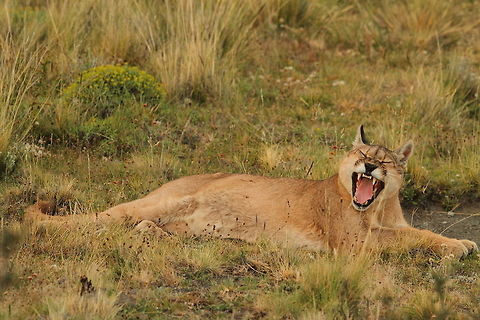
Reproduction
Females reach sexual maturity between one-and-a-half to three years of age. They typically average one litter every two to three years throughout their reproductive lives, though the period can be as short as one year. Females are in estrus for about 8 days of a 23-day cycle; the gestation period is approximately 91 days. Females are sometimes reported as monogamous, but this is uncertain and polygyny may be more common. Copulation is brief but frequent. Chronic stress can result in low reproductive rates when in captivity as well as in the field.Only females are involved in parenting. Female cougars are fiercely protective of their cubs, and have been seen to successfully fight off animals as large as Grizzly bears in their defense. Litter size is between one and six cubs; typically two. Caves and other alcoves that offer protection are used as litter dens. Born blind, cubs are completely dependent on their mother at first, and begin to be weaned at around three months of age. As they grow, they begin to go out on forays with their mother, first visiting kill sites, and after six months beginning to hunt small prey on their own. Kitten survival rates are just over one per litter. When cougars are born, they have spots, but they lose them as they grow, and by the age of 2 1/2 years, they will completely be gone
Young adults leave their mother to attempt to establish their own territory at around two years of age and sometimes earlier; males tend to leave sooner. One study has shown high mortality amongst cougars that travel farthest from the maternal range, often due to conflicts with other cougars . Research in New Mexico has shown that "males dispersed significantly farther than females, were more likely to traverse large expanses of non-cougar habitat, and were probably most responsible for nuclear gene flow between habitat patches."
Life expectancy in the wild is reported at eight to 13 years, and probably averages eight to 10; a female of at least 18 years was reported killed by hunters on Vancouver Island. Cougars may live as long as 20 years in captivity. One male North American cougar , named Scratch, was two months short of his 30th birthday when he died in 2007. Causes of death in the wild include disability and disease, competition with other cougars, starvation, accidents, and, where allowed, human hunting. Feline immunodeficiency virus, an endemic HIV-like virus in cats, is well-adapted to the cougar.
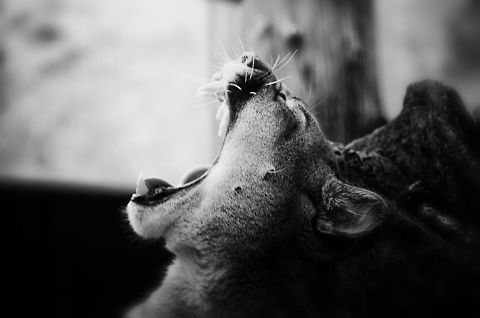
Food
A successful generalist predator, the cougar will eat any animal it can catch, from insects to large ungulates . Like all cats, it is an obligate carnivore, meaning it needs to feed exclusively on meat to survive. The mean weight of vertebrate prey that pumas attack increases with the puma's body weight; in general, MWVP is lower in areas closer to the equator. Its most important prey species are various deer species, particularly in North America; mule deer, white-tailed deer, elk and even bull moose are taken. Other species such as the bighorn and Dall's sheep, horse, fallow deer, caribou, mountain goat, coyote, pronghorn, and domestic livestock such as cattle and sheep are also primary food bases in many areas. A survey of North America research found 68% of prey items were ungulates, especially deer. Only the Florida panther showed variation, often preferring feral hogs and armadillos.Investigation in Yellowstone National Park showed that elk, followed by mule deer, were the cougar's primary targets; the prey base is shared with the park's gray wolves, with which the cougar competes for resources....snipped...* ...snipped...* ...snipped... Another study on winter kills in Alberta showed that ungulates accounted for greater than 99% of the cougar diet. Learned, individual prey recognition was observed, as some cougars rarely killed bighorn sheep, while others relied heavily on the species.
In Pacific Rim National Park Reserve, scat samples showed raccoons to make up 28% of the cougar's diet, harbor seals and blacktail deer 24% each, North American river otters 10%, California sea lion 7%, and American mink 4%; the remaining 3% were unidentified....hieroglyph snipped...
In the Central and South American cougar range, the ratio of deer in the diet declines. Small to mid-sized mammals are preferred, including large rodents such as the capybara. Ungulates accounted for only 35% of prey items in one survey, about half that of North America. Competition with the larger jaguar has been suggested for the decline in the size of prey items. Other listed prey species of the cougar include mice, porcupines, beavers, raccoons, hares, guanaco, peccary, vicuna, rhea, and wild turkey. Birds and small reptiles are sometimes preyed upon in the south, but this is rarely recorded in North America. Not all of their prey is listed here due to their large range.
Though capable of sprinting, the cougar is typically an ambush predator. It stalks through brush and trees, across ledges, or other covered spots, before delivering a powerful leap onto the back of its prey and a suffocating neck bite. The cougar is capable of breaking the neck of some of its smaller prey with a strong bite and momentum bearing the animal to the ground.
Kills are generally estimated around one large ungulate every two weeks. The period shrinks for females raising young, and may be as short as one kill every three days when cubs are nearly mature around 15 months. The cat drags a kill to a preferred spot, covers it with brush, and returns to feed over a period of days. The cougar is generally reported to not be a scavenger, and rarely consumes prey it has not killed, but deer carcasses left exposed for study were scavenged by cougars in California, suggesting more opportunistic behavior.
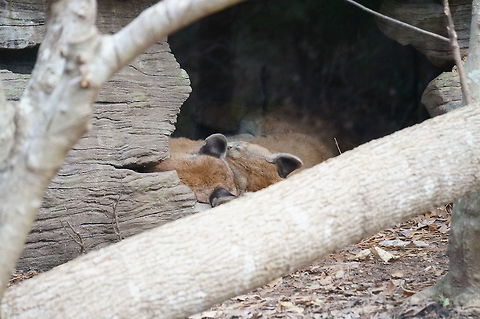
Evolution
Cougars are the largest of the small cats. They are placed in the subfamily Felinae, although their bulk characteristics are similar to those of the big cats in the subfamily Pantherinae. The family Felidae is believed to have originated in Asia about 11 million years ago. Taxonomic research on felids remains partial, and much of what is known about their evolutionary history is based on mitochondrial DNA analysis, as cats are poorly represented in the fossil record, and significant confidence intervals exist with suggested dates.In the latest genomic study of the Felidae, the common ancestor of today's ''Leopardus'', ''Lynx'', ''Puma'', ''Prionailurus'', and ''Felis'' lineages migrated across the Bering land bridge into the Americas 8.0 to 8.5 million years ago . The lineages subsequently diverged in that order. North American felids then invaded South America 3 Mya as part of the Great American Interchange, following formation of the Isthmus of Panama. The cougar was originally thought to belong in ''Felis'' , the genus which includes the domestic cat. As of 1993, it is now placed in ''Puma'' along with the jaguarundi, a cat just a little more than a tenth its weight.
The cougar and jaguarundi are most closely related to the modern cheetah of Africa and western Asia, but the relationship is unresolved. The cheetah lineage is suggested by some studies to have diverged from the ''Puma'' lineage in the Americas and migrated back to Asia and Africa, while other research suggests the cheetah diverged in the Old World itself. The outline of small feline migration to the Americas is thus unclear.
A high level of genetic similarity has been found among North American cougar populations, suggesting they are all fairly recent descendants of a small ancestral group. Culver ''et al.'' propose the original North American population of ''P. concolor'' was extirpated during the Pleistocene extinctions some 10,000 years ago, when other large mammals, such as ''Smilodon'', also disappeared. North America was then repopulated by a group of South American cougars.
References:
Some text fragments are auto parsed from Wikipedia.